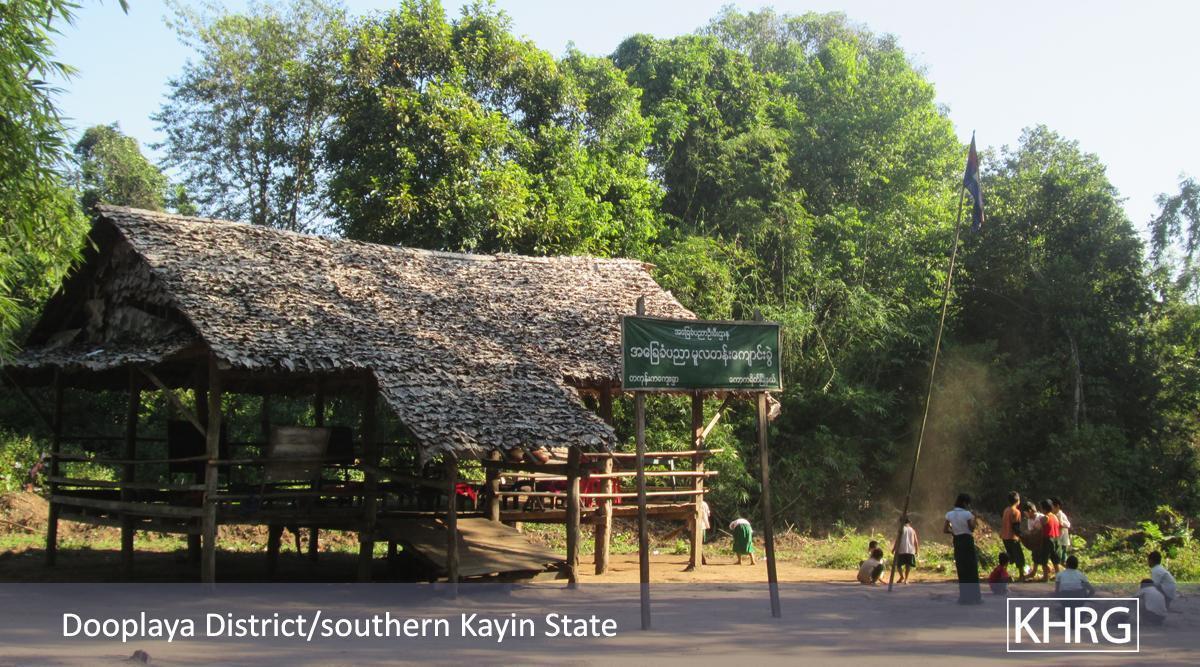This Situation Update describes events occurring in Kaw T’Ree Township, Dooplaya District, in the period from March to May 2023. In March 2023, the State Administration Council (SAC) conducted indiscriminate shelling on two occasions into villages in Maw Hkee village tract and Choo K’Lee village tract, Kaw T’Ree Township. Villagers were forced to flee from these areas and encountered livelihood challenges as a result. In the following months, the SAC soldiers reduced their attacks in the area, and so displaced villagers were able to return.[1]
Indiscriminate Shelling and Displacement
On March 5th 2023, State Administration Council (SAC)[2] Light Infantry Battalion (LIB)[3] #560 and Infantry Battalion (IB)[4] #32 indiscriminately shelled artillery weapons into Maw Hkee village, Maw Hkee village tract[5], Kaw T’Ree Township, Dooplaya District. This resulted in villagers from Maw Hkee village, estimated as over 1,000 people, being forced to flee to plantation fields in the Thai-Burma borderland area, enlarging the already extensive displaced population there. In addition, villagers from Htee K’Pler village, A--- village, and Kaw La Mee village, in Choo K’Lee village tract (which is near to Maw Hkee village tract), also fled in fear, to a different location in the Thai-Burma borderland area.
On March 20th 2023, SAC soldiers from LIB #560 once again conducted shelling, this time directed at the Karen National Liberation Army (KNLA)[6] Battalion #103, who were based in A--- village, Choo K’Lee village tract, Kaw T’Ree Township. Following this incident, around 800 villagers from the surrounding area sheltered near A--- village, in the Thai-Burma borderland area.
From April 23rd 2023, SAC soldiers from LIB #560 and IB #32 reduced their military activities, meaning that some villagers from Htee K’Pler village, A--- village, Kaw La Mee village, and K’Neh Hkler village, in Ta Auh Hta village tract, started returning to their villages. As the SAC had stopped conducting indiscriminate shelling into villages, from May 10th 2023, all the internally displaced persons, villagers from Htee K’Pler village, Kaw La Mee village, K’Neh Hkler village, and A--- village, who were sheltering in an area within Choo K’Lee village tract at the Thai borderland, returned to their villages.
Livelihood difficulties
While these villagers were displaced, they were not able to work as daily labourers [and farmers] as they were living far from their usual working environments and they therefore did not have any access to income nor any savings. Villagers did not dare to return to work in their plantations for fear of attack by the SAC. During the displacement period, some internally displaced persons received humanitarian support that included one sack of rice per month from the Committee for Internally Displaced Karen People (CIDKP).
Further background reading on the situation of indiscriminate shelling and displacement in Southeast Burma can be found in the following KHRG reports:
- “Striking Fear: Impacts of State Administration Council (SAC) shelling on villagers’ lives in Southeast Burma (January to October 2023)”, December 2023.
- “Mergui-Tavoy District Incident Report: Two villagers killed and two injured by the SAC shelling in Ler Muh Lah Township, July 2023”, November 2023.
- “Doo Tha Htoo District Situation Update: Two villagers were killed and 17 villagers were injured by SAC’s indiscriminate shelling in Kyeh Htoh Township (December 2022 to February 2023)”, August 2023.
Footnotes:
[1] The present document is based on information received in May 2023. It was provided by a community member in Dooplaya District who has been trained by KHRG to monitor human rights conditions on the ground. The names of the victims, their photos and the exact locations are censored for security reasons. The parts in square brackets are explanations added by KHRG.
[2] The State Administration Council (SAC) is the executive governing body created in the aftermath of the February 1st 2021 military coup. It was established by Senior General Min Aung Hlaing on February 2nd 2021, and is composed of eight military officers and eight civilians. The chairperson serves as the de facto head of government of Burma/Myanmar and leads the Military Cabinet of Myanmar, the executive branch of the government. Min Aung Hlaing assumed the role of SAC chairperson following the coup.
[3] A Light Infantry Battalion (LIB) comprises 500 soldiers. Most Light Infantry Battalions in the Tatmadaw are under-strength with less than 200 soldiers, yet up-to-date information regarding the size of battalions is hard to come by, particularly following the signing of the NCA. LIBs are primarily used for offensive operations, but they are sometimes used for garrison duties.
[4] An Infantry Battalion (IB) of the Burma Army comprises 500 soldiers. However, most Infantry Battalions in the Tatmadaw are under-strength with less than 200 soldiers. Yet up-to-date information regarding the size of battalions is hard to come by, particularly following the signing of the National Ceasefire Agreement (NCA). They are primarily used for garrison duty but are sometimes used in offensive operations.
[5] A village tract is an administrative unit of between five and 20 villages in a local area, often centred on a large village.
[6] The Karen National Liberation Army is the armed (KNLA) wing of the Karen National Union (KNU).



